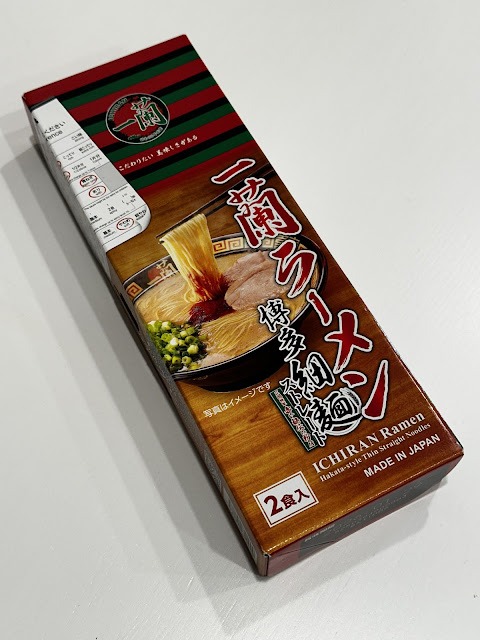Hey everyone! This is a pretty cool instant ramen hack from the folks at Nissin Japan that uses their deluxe RAOH noodles (that are reduced fat too as they are air dried). I've reviewed other RAOH brand noodles before, mainly as bowl noodles, but not their whole grain foil packaged variety. This is an extra special review as I will show you the cooking process for a ramen bowl with some stir-fried toppings like they would do in Osaka or Yokohama. Making noodles this way works pretty good, but you'll need to size your frying pan or pot to make sure you can accommodate two packages of noodles, the stir fry ingredients, and the soup.
I start with the Nissin RAOH Shoyu flavour instant noodles. These are good quality, air dried noodles that have more nutrients and fibre than their regular noodles, and are reduced fat at 6.3 grams. All good stuff and it just gets better.
 |
| Front of the package of RAOH Shoyu Whole Grain noodles. |
 |
| Back of the package with manufacturing, nutritional, and ingredients info. |
So you need a whole bunch of veggies to accompany this dish to make it a meal. I would use an eighth of a small cabbage per serving, or a quarter cabbage for two servings (but up it if you like cabbage). The cabbage should be sliced into small squares or stips to facilitate stir frying. I used a quarter of a large carrot or half a medium carrot that is sliced into thin strips for two servings. Finally, I diced two green onions into long segments for two servings.
 |
| Noodle blocks and veggies. You can see the noodles and the powdered and liquid soup packets at the right. |
Preheat a large frying pan / pot to medium heat and use only 1 tablespoon of oil to keep the fat content down. You can start with the cabbage to get it going as it is a bulky veggie. Stir the cabbage until it cooks down a bit then add the carrots. Keep stir frying, then add the green onions. This shouldn't take more than 4 minutes at most.
 |
| Stir fried cabbage, carrots, and green onion. |
If you have some leftover meat like roast chicken or ham, you can then add it to the mix. If using some sandwich meat like I did in this case, use honey ham / regular roast beef as they add fewer additional seasonings. Cook for less than a minute.
 |
| Ham added to the stir fry. |
Finally, add the water you need to rehydrate the noodles and make the soup. For these noodles, it was 450 mL per serving for a total of 900 mL. This is why you need a big pan. You can also add in the soup powder and liquid at this time and mix it up. Turn up the heat to get the water to boil faster and it should start to smell good.
When the water boils, you immediately add in the noodle blocks. You will need to immerse them and probably need to push some of the stir fry out of the way. You can also flip the noodle blocks to have both sides get water and heat equally. The blocks will soften quickly and you will need to stir the noodles around in the soup. You want the noodles to rehydrate well.
 |
| Noodle blocks hydrating. |
Stir the noodles around well and let them soak in the soup to get all soft and chewy. These noodles hydrate in about 4 minutes. I usually go for like 3 1/2 rather than the full 4 as you will get a firmer noodle.
 |
| Noodle blocks all broken down and mixed into the soup. |
Finally it is time to eat. Dish out the noodles first (spaghetti ladle or chopsticks works well), then the vegetables, and then pour / ladle soup into two large bowls for tasty meals. The finished Shoyu ramen with stir fry should look something like the picture below. It is full of soy soup flavour and sweet / succulent veggies to accompany the firm and chewy noodles. This makes for a good meal, so thanks Nissin! I really enjoyed making this and eating it even more. The whole grain noodles are good, not grainy, and are pretty much like their regular RAOH noodles.
 |
| RAOH Shoyu noodle soup with stir fried veggies. Yum. |
Follow me on Twitter a
@Tostzilla or my
feedburner for this blog.
More cup noodle / instant ramen reviews and Japanese pop culture.



















Comments
Post a Comment